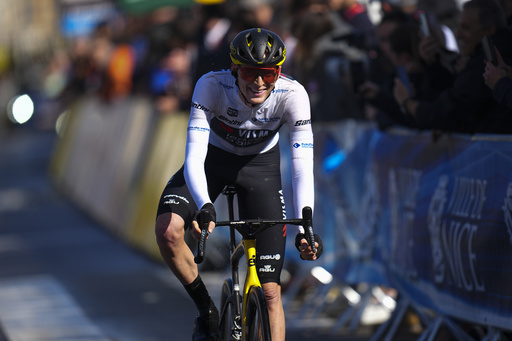Tadej Poga?ar is set to further cement his status in the cycling world as he chases a fourth Tour de France triumph. The 26-year-old from Slovenia made history last year by becoming the first rider since Marco Pantani in 1998 to achieve a Giro d’Italia and Tour double in the same season. This year, his main contender will be Jonas Vingegaard, a Danish cyclist who has previously won the Tour de France and is eager to reclaim victory after falling short last season.
The Tour de France kicks off on July 5 in Lille, located in northern France. Participants will embark on a grueling journey encompassing 21 stages and covering a total distance of 3,339 kilometers (2,070 miles).
The race concludes on July 27, deviating from the usual parade finish. Instead, the final day will feature a challenging climb up Montmartre Hill amidst narrow cobbled streets, enhancing what is traditionally a subdued finale with an element of suspense. Concerns have been raised about safety due to expected large crowds, akin to those of last year’s Olympics.
Poga?ar remains the favorite, especially after a recent dominant performance at the Critérium du Dauphiné, bolstering his confidence with victories during the spring classics. His extraordinary skills, especially in the Tour’s punishing mountain stages, make him a formidable competitor. However, Vingegaard poses a serious threat if he returns to peak form and if his Visma-Lease a Bike team can rival the efficiency of Poga?ar’s UAE Team Emirates through challenging mountain segments.
Other potential challengers include Slovenian veteran Primož Rogli?, who narrowly lost the 2020 Tour to Poga?ar. Rogli?, renowned for winning the Spanish Vuelta four times, could still emerge as a significant contender. Remco Evenepoel, a double Olympic champion, has consistently stayed on Poga?ar’s wheel during aggressive uphill attacks this year despite previous injuries. João Almeida, Poga?ar’s teammate, has the aptitude to lead and could possibly step up if circumstances permit. American cyclist Matteo Jorgenson, an upcoming talent who defended his Paris-Nice title this year, and Simon Yates, a Giro d’Italia winner, both ride for Vingegaard’s team and could seize the limelight if their leader falters.
The Tour commences with 184 riders from 23 teams. Attrition due to injuries, fatigue, or challenges in mountain stages is common, as evidenced by last year’s 141 finishers out of 176 starters.
This year’s competition consists of 21 stages, including seven flat, six hilly, and six mountain stages—incorporating five mountain finishes at Hautacam, Luchon-Superbagnères, Mont Ventoux, Courchevel Col de la Loze, and La Plagne Tarentaise—with two time trials. The Col de la Loze, at 2,304 meters, marks the pinnacle of the Tour. Uniquely, the route will stay within French borders for the first time since 2020. Stage victories will award time bonuses of 10, 6, and 4 seconds to the first three finishers respectively.
Recent champions preceding Poga?ar and Vingegaard include one-time winners such as Colombian Egan Bernal in 2019 and British cyclist Geraint Thomas in 2018 for Team Sky. This team also boasted victories with Chris Froome in 2013, 2015, 2016, and 2017 and with Bradley Wiggins in 2012. Vincenzo Nibali from Italy claimed the title in 2014.
Television coverage for the race is extensive, with France Télévisions and Eurosport delivering daily updates in France, while U.S. audiences can tune in via NBC and Peacock.
While fan interaction can sometimes lead to riders experiencing close proximity with overenthusiastic supporters, with some opting to run alongside or in front of cyclists during mountain ascents, a general understanding exists to avoid physical contact with the competitors.
The presence of team cars, often driven by sporting directors, is another staple of the race. These vehicles provide strategic guidance and support via radio communication, occasionally maneuvering through tight spaces during mountain passes, which sometimes leads to traffic bottlenecks on the roads.


